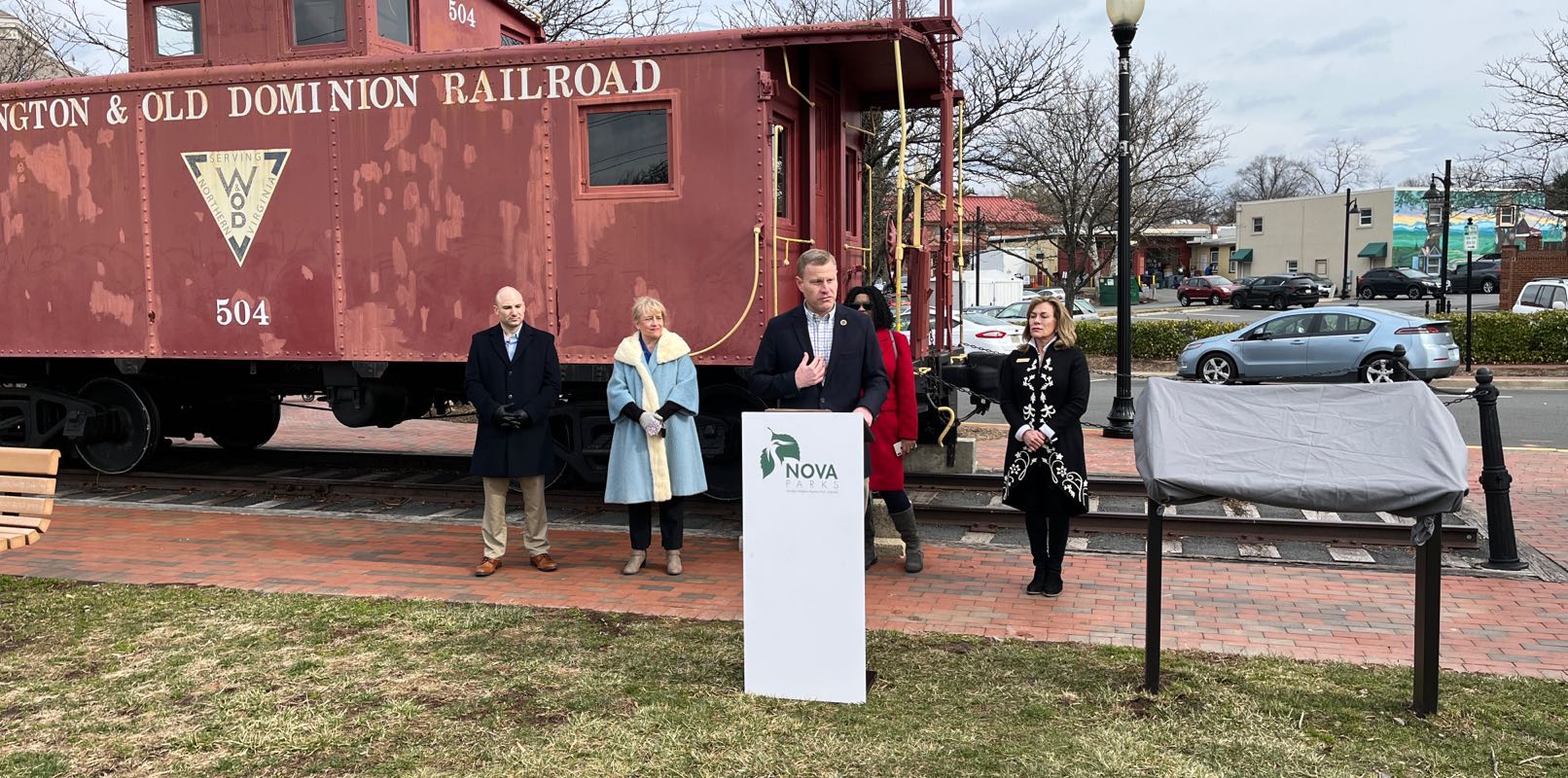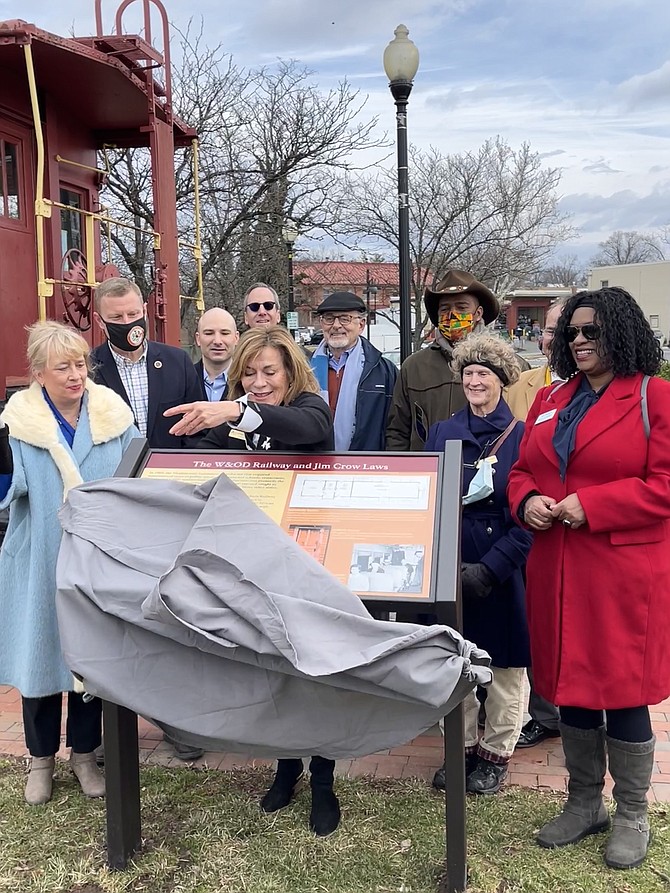Cate Magennis Wyatt, Loudoun County board chairperson NOVA Parks unveils NOVA Park's new interpretive sign panel, "The W&OD Railway and Jim Crow Law." The W&OD Trail runs through the Town of Herndon beside the iconic Washington & Old Dominion Red Caboose.
On Saturday, Feb. 26, NOVA Parks unveiled two new interpretive sign panels along its Washington & Old Dominion (W&OD) Trail. The outdoor panels acknowledge Virginia's Jim Crow laws (1900) that mandated that all train companies segregate white and black passengers.
 Jeff McKay, chairman of Fairfax County Board of Supervisors, speaks while behind him stand (from left) Steve Descano, Fairfax County Commonwealth's Attorney; Sheila Olem, mayor of the Town of Herndon; Karen Campblin, president of the Fairfax County NAACP; and Cate Magennis Wyatt, Chairwoman of NOVA Parks board.
Jeff McKay, chairman of Fairfax County Board of Supervisors, speaks while behind him stand (from left) Steve Descano, Fairfax County Commonwealth's Attorney; Sheila Olem, mayor of the Town of Herndon; Karen Campblin, president of the Fairfax County NAACP; and Cate Magennis Wyatt, Chairwoman of NOVA Parks board.
Southern Railway owned the railway bed at the time known as the Bluemont Branch, which is now the W&OD Trail. It is the paved 45-mile route from Arlington running through the urban heart of Fairfax County that ends in the countryside town at Purcellville Train Station in Loudoun County. The first ceremony occurred at 10 a.m. in Fairfax County, at the Red Caboose in the Town of Herndon, while the second ceremony was held later that day in Loudoun County, at the trail crossing South King Street in Leesburg.
A week earlier, the sign was unveiled in Arlington.
Cate Magennis Wyatt, Loudoun County representative and NOVA Parks board chairwoman, described how, in 1959, visionaries from several jurisdictions got together to create and run a system of regional parks that now, 63 years later, spans 12,000 acres. According to Wyatt, parks are not only about areas to recreate. They are also about creating environmentally and historically significant places, "even when that means holding up a mirror to the worst chapters in our shared American stories."
"We are here today to recognize that this 45-mile long linear park, the WO&D, is for us to enjoy but to recognize those who rode it. They suffered injustices with no social or judicial reason," she said.
It was not until 1964, when President Lyndon B. Johnson signed the Civil Rights Act, that segregation, which Jim Crow laws had entrenched, was officially abolished. The laws had been named after a white minstrel who performed in blackface makeup as "Jim Crow," a derogatory depiction of a black character.
"In the 1900s, the Virginia legislature passed a law that required separation of the races in public spaces," the opening lines of the panels read. "This included schools, restaurants, hotels, and public transportation — which at the time was primarily the use of trains. This was nicknamed the ‘Jim Crow’ law and sought to perpetuate discrimination against people of color."
 Karen Campblin, president of the Fairfax County NAACP speaks at the unveiling.
Karen Campblin, president of the Fairfax County NAACP speaks at the unveiling.
According to the National Park Service, Virginia's Jim Crow law said that "the conductors or managers on all such railroads shall have power, and are hereby required, to assign to each white or colored passenger his or her respective car, coach, or compartment. If the passenger fails to disclose his race, the conductor and managers, acting in good faith, shall be the sole judges of his race."
Wyatt said those present for the interpretive panel's unveiling were surrounded by leaders who chose to use their time and talents to "always step into the light of injustice and speak truth to power." She introduced Karen Campblin, president of the Fairfax County NAACP, as a person “who has done so."
During the Jim Crow era, rail transportation provided food, medical treatment, and economic opportunities in labor, according to Campblin. But "not so much so" for black people, she said. African Americans were poorly treated, forced to sit in waiting rooms in intolerable conditions. They were forced to board and disembark without humanity, forced to jump off trains rather than step down.
"In addition, sometimes their compartments were used for extra luggage from their white counterparts or to carry livestock, hogs, and other things, while they paid the same amount of fare for traveling," Campblin said. "As a community, we overcame, we persevered, and we contributed to a community despite how we were treated,"
Jeffrey McKay, chairman of the Fairfax County Board of Supervisors. congratulated Paul Gilbert, executive director of NOVA Parks, and others who ensured that NOVA Parks was not merely for leisure and that history was not being erased. "They're telling history about the most divisive time in American history, and to not tell that story is, in and of itself, divisive … It is the moral compass of the county to make sure the stories get told," McKay said.
McKay presented Karen Campbin with a proclamation from the Board of Supervisors declaring February 2022 to be African American History Month. "And in my world … every month of the year is African American History Month," he said.
Fairfax County Commonwealth's Attorney Steve Descano described "a history of injustice."
"Everyone standing behind me works every day to move their parcel of the world, their community forward, and also to eradicate those messages of past injustice, whether it is in housing, business development, or, in my case, the criminal justice system," he said. "We are smart to recognize that true dynamism moving forward to progress can only be accomplished if we always keep in mind the failures of our past."
